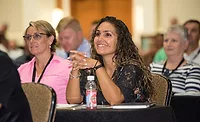New Vantage Point
Roofing contractors from Ohio aim to take drone imagery to new heights
.webp?t=1651693257)
Kiesel, seen here at the 2021 Best of Success conference, formed Imagine Technologies Group along with Resides to push the limits of drone technology in roofing.
After three long days of flashing smiles, mixing handshakes and pandemic-friendly elbow bumps, and talking about their vision for the future of roofing, John Kiesel and Ryan Resides could finally pause for a minute and take it all in.
Sitting on the top floor of the Ernest M. Morial Convention Center in New Orleans, the two roofers by trade and newly-turned tech entrepreneurs could hardly believe the number of people they met and eyes they opened throughout the 2022 International Roofing Expo (IRE). As representatives for their new company, Imagine TechnologiesGroup (ITG), they spent the better part of the previous 72 hours talking about the future of drones in the roofing contractor space, and their unique contribution to the conversation.
For about the last 18 months, the two have worked closely on developing a new, cloud-based imagery software with the potential to revolutionize how roofers — and contractors in several other fields — do their jobs. It’s called Advanced Imagery with Optelos, and was a unanimous selection for RC’s 2022 Editor’s Choice.

Imagine Technologies Group’s Kim Stalica assists Ryan Groth, of Sales Transformation Group, with the Advanced Imagery Solutions with Optelos program. About a dozen roofing contractors and other industry stakeholders experienced the VR technology during a demonstration with the Roofing Technology Think (RT3) in New Orleans during IRE 2022.

“This whole experience has been an eye opener for people, and for us as well,” said Imagine Technology Group President John Kiesel. “We’ve gotten this far in this amount of time, and I’m very proud of the work we’ve done.”

Rackley Roofing Company President Curtis Sutton and COO Michelle Boykin try out ITG's drone imagery with KPost Roofing & Waterproofing Head Coach Steve Little.
Whether it was hands-on presentations with leaders in the roofing technology space, networking at fundraisers, presenting with industry experts in educational sessions, or partnering with tech companies on the show floor, Kiesel and Resides kept busy and focused. They built up the momentum for the show while maintaining their owner/estimator roles at Division 7 Roofing, a leading commercial roofing company with five decades of history serving greater Columbus and central Ohio.
It was hardly the first IRE Kiesel attended in his two decades of roofing, but he said it will be his most memorable.
“It’s been a whirlwind, and as of yet, no one has told us it’s a bad idea, so that’s encouraging,” Kiesel said humbly. “This whole experience has been an eye opener for people, and for us as well. We’ve gotten this far in this amount of time, and I’m very proud of the work we’ve done.”
Taking Flight
Early adopters of using drones to help with their roofing maintenance programs and estimates, Kiesel and Resides are planning to take drone usage in the roofing space to the next level. They’ve developed a system that designs specific flight patterns customizable for any roof and paired it with a powerful, cloud-based software platform that stitches together thousands of photo images. The result is a consistent, virtually real-time view of the rooftop that can be analyzed for multiple purposes.
And with a virtual reality integration provided by Optelos software, they’re able to present it to facility managers and building owners in a unique 3-D model that immerses the user in the experience of being on a rooftop without leaving their chair.
While photogrammetry — the science of capturing high-precision measurements with photos or other imagery — is hardly new to the roofing industry, ITG created some features that not only dramatically improve the user experience, but will save roofing contractors money, Kiesel said. Using his own roofing company as the guinea pig, Kiesel created his own case study after he got so tired of repeated mistakes with roof takeoffs. Using drones to take pictures was an improvement over spending man hours roaming rooftops, but he needed a process to optimize the drone fly over and capture the data required to accomplish the goal. That also required doing it in a specific way that accounts for a number of variables including: height of flight; speed of flight; roof material overlay; camera shudder speeds and settings; time of day; and weather conditions.
“We figured out a way to say here’s how you do this, and it’s going to be easier because each step is planned out,” said Kiesel.
Optelos made ITG pioneers as a partner in the roofing vertical to use their platform with the specific roofing application. While it helps being comfortable with drone technology, it’s not a must, developers insist. Neither is having any background in artistic design.
“I’ve always been operationally driven, coming from the field,” said Kiesel, who joined his father’s roofing crew the day after graduating high school. “I can’t draw a square without getting turned around somehow, but I can recognize the issues in a crew and mistakes on a roof, and I’m passionate about not repeating them forever.”
Equally as passionate about that — and technology — is Resides, who came to Division 7 with a background in national sales in 2017. Kiesel said he found him on LinkedIn and ready for a change when they met over breakfast and talked about the family feel of the company, and the roofing industry as a whole.
Resides started out in account management and said he got a thorough crash course in roofing by sharing an office with Craig Mcginnis, Division 7’s vice president of production and in-house “encyclopedia” of roofing. He said he felt like his roofing horizons quadrupled, learning enough to step into the estimator’s role when it opened up. Early on his watch, Division 7 secured its largest single contract in company history and set a record for annual revenue.
“The team was feeding me (knowledge) every day, and you start to build that up,” Resides explained. “It’s because of them … they pour themselves into you and you’re able to pour yourself back into the company. It’s a beautiful feedback loop that just continues and extends over time.”

The Advanced Imagery Solutions with Optelos system creates a 3-D model of any building built on thousands of images captured by a drone and stitched together with new, innovative software. Courtesy of ITG.

The result of stitching together drone images is a consistent, virtually real-time view of the rooftop that can be analyzed for multiple purposes.

“In our minds, this will help tremendously with the workforce issue ... but there needs to be something a little more sexy about roofing to attract the younger generation." - Ryan Resides
Teaching and Trending Up
Resides also had tools to work with and the freedom to experiment.
Kiesel said that every three to four roofing jobs, he noticed a bottleneck problem occurring that could have been avoided if detected earlier. Using drone imagery as a possible solution was brought to them by a potential superintendent candidate with a passion for drones. He started flying the buildings with drones and taking photos so Resides could begin virtually estimating the job without ever having to set foot on the roof.
“If you’ve ever sat there estimating, clicking your life away for hours and hours, this is a solution,” Resides told roofers and other attendees at the Roofing Technology Think Tank (RT3) meeting in New Orleans the day before the IRE kicked off. “We have something that could affect all areas of your business, and it’s up to you to decide how you want to implement it.”
Stitching the images together to provide a consistent model that could help measure and identify roofing issues with pinpoint accuracy was the next innovation. Following that was integrating with a platform that could be easily included in a sales presentation and gave the viewer a first-hand experience to not only understand the problem on the roof, but also help envision the solution.
The potential benefits for the technology range widely from safety, rooftop efficiency and cost savings in man hours and materials, to name a few. While excited about those, the developers say they’re also looking forward to the unknown benefits that they believe will materialize once it gets widespread use.
Having these tools available to attract the right type of younger workers is what the industry needs, at just the right time, Resides said.
“We want to elevate the thought process of all the people in this industry to understand and grasp control of finding solutions,” he explained. “In our minds, this will help tremendously with the workforce issue ... but there needs to be something a little more sexy about roofing to attract the younger generation. There’s an expectation of technology out there, and if you don’t have these tools available to make their work lives better, they’re not going to want to work for you.”
Kiesel and Resides said they’re already seeing the change within high school students they’ve demonstrated the technology to at local skilled-trade programs. Getting paid to fly drones and interpret data does have its appeal.
“We’re showing them the tech, and they’re surprised to learn that we’re roofers,” Resides said. “We simply tell them that we’re going to show you how to use this technology and how you’re going to help our business evolve in a positive way.
“Welcome to the next generation of roofing contractors, and we’ve got a spot for you.”
Looking for a reprint of this article?
From high-res PDFs to custom plaques, order your copy today!







